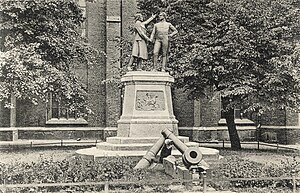
Back حصار كولبيرغ (1807) Arabic Belagerung Kolbergs 1807 German Siège de Colberg (1807) French Kolberg ostroma (1807) Hungarian Assedio di Kolberg (1807) Italian कोलबर्गचा वेढा (१८०७) Marathi Oblężenie Kołobrzegu Polish Осада Кольберга (1807) Russian Belägringen av Kolberg Swedish Kolberg Kuşatması (1807) Turkish
| Battle of Kolberg (1807) | |||||||
|---|---|---|---|---|---|---|---|
| Part of the War of the Fourth Coalition | |||||||
 Former battle memorial with statues of Nettelbeck and Gneisenau in Kolberg | |||||||
| |||||||
| Belligerents | |||||||
|
| |||||||
| Commanders and leaders | |||||||
|
|
| ||||||
| Strength | |||||||
|
14,000[6][5] 41 guns[6][dubious ] |
6,000[6][5] 230 guns[6] 46 guns on Swedish frigate | ||||||
| Casualties and losses | |||||||
| 5,000 killed, wounded or captured[6][5] | 3,000 killed, wounded or captured[6][5] | ||||||
The siege of Kolberg (also spelled Colberg or Kołobrzeg)[7][8][9][10] took place from March to 2 July 1807 during the War of the Fourth Coalition, part of the Napoleonic Wars. An army of the First French Empire and several foreign auxiliaries (including Polish insurgents) of France besieged the fortified town of Kolberg, the only remaining Prussian-held fortress in the Province of Pomerania. The siege was not successful and was lifted upon the announcement of the Peace of Tilsit.
After Prussia lost the Battle of Jena–Auerstedt in late 1806, French troops marched north into Prussian Pomerania. Fortified Stettin (Szczecin) surrendered without battle, and the province became occupied by the French forces. Kolberg resisted, and the implementation of a French siege was delayed until March 1807 by the freikorps of Ferdinand von Schill operating around the fortress and capturing the assigned French commander of the siege, Victor-Perrin. During these months, the military commander of Kolberg, Lucadou, and the representative of the local populace, Nettelbeck, prepared the fortress's defensive structures.
The French forces commanded by Teulié, composed primarily of troops from Italy, succeeded in encircling Kolberg by mid-March. Napoleon put the siege force under the command of Loison; Frederick William III entrusted Gneisenau with the defense. In early April, the siege forces were for a short time commanded by Mortier, who had marched a large force from besieged Swedish Stralsund to Kolberg but was ordered to return when Stralsund's defenders gained ground. Other reinforcements came from states of the Confederation of the Rhine (Kingdom of Württemberg, Saxon duchies and the Duchy of Nassau), the Kingdom of Holland, and France.
With the western surroundings of Kolberg flooded by the defenders, fighting concentrated on the eastern forefield of the fortress, where Wolfsberg sconce had been constructed on Lucadou's behalf. Aiding the defense from the nearby Baltic Sea were a British and a Swedish vessel. By late June, Napoleon massively reinforced the siege forces to bring about a decision. The siege force then also concentrated on taking the port north of the town. On 2 July, fighting ceased when Prussia had agreed on an unfavourable peace after her ally Russia suffered a decisive defeat at Friedland. Of the twenty Prussian fortresses, Kolberg was one of the few remaining in Prussian hands until the war's end. The battle became a myth in Prussia and was later used by Nazi propaganda efforts. While prior to World War II the city commemorated the defendants, it started to honor the commander of the Polish troops after 1945, when the city became part of a Polish state.
- ^ a b Wörner 2004, p. 15.
- ^ a b c Lilienstern 2008.
- ^ Erkenbrecher 1998, p. 15.
- ^ Burgdorf 2006, p. 58.
- ^ a b c d e f Bodart 1908, p. 384.
- ^ a b c d e f Smith 1998, p. 252.
- ^ Davies 2006, p. 393.
- ^ Ross 2008, p. 377.
- ^ Zawadzki 2009, pp. 110–124.
- ^ Horward 1986, p. 639.
© MMXXIII Rich X Search. We shall prevail. All rights reserved. Rich X Search
